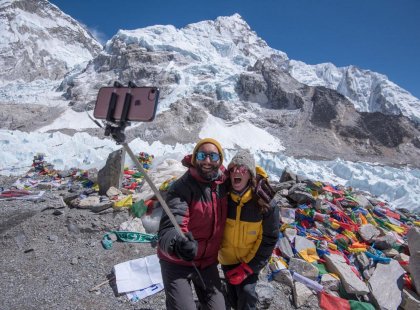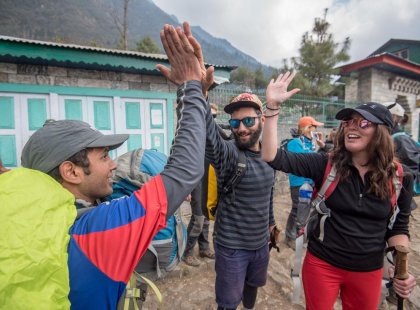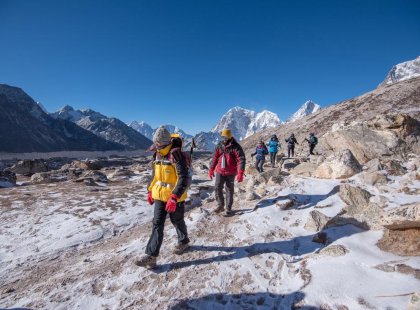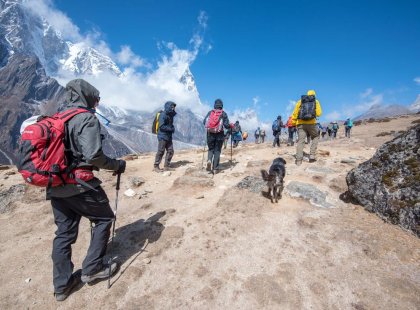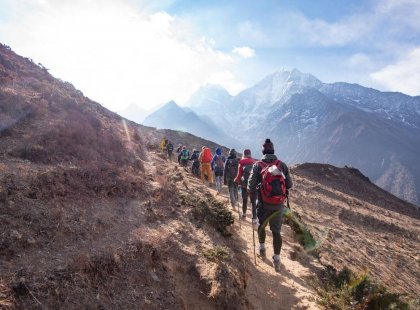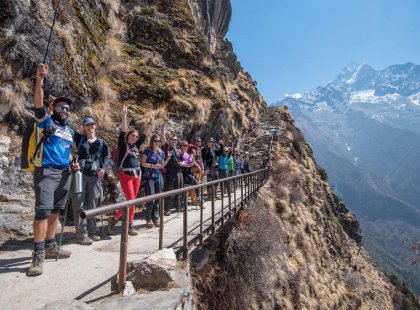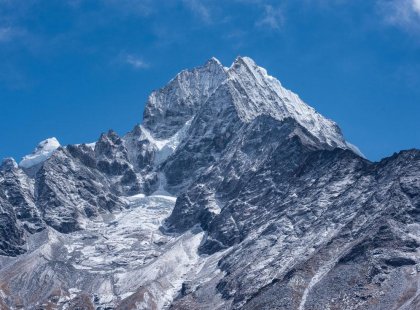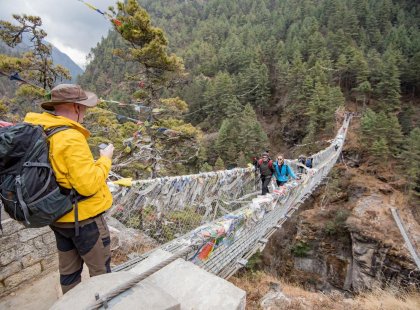Travel from Kathmandu to some of the world’s highest mountains. Experience the high mountains of Nepal on this challenging trekking adventure. Conquer Everest's Base Camp, a holy grail for mountaineers, and complete the arduous Annapurna Circuit. Take in stunning scenery and soak up the rich cultures and traditions of this beautiful country, exploring tiny villages and meeting friendly locals along the way. Ever dreamed of seeing the wind-swept peak of Everest, of traversing high passes and crossing blue-white glaciers, of meeting holy men and taking in nature at its grandest? This trip has it all. ALTERNATE ITINERARY: In case of weather conditions leading to cancellations or delays of included flights, this trip will operate on an alternate itinerary. Please see Day 1 of the itinerary for more details.
-
Duration: 31 daysService level: Standard
-
Starts in: Kathmandu ValleyPhysical Grading: Challenging
-
Ends in: Kathmandu ValleyAges: 16+
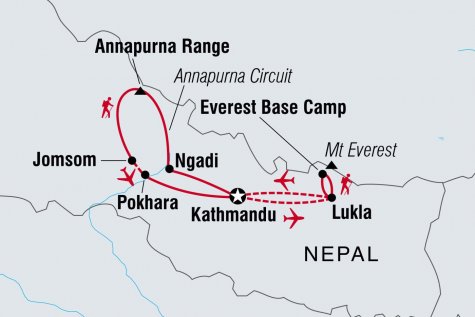
Itinerary
Start place: Kathmandu Valley
ALTERNATIVE ITINERARY DUE TO FLIGHT CANCELLATIONS:
Weather conditions in the Himalayas can change rapidly, which frequently results in the need for changes to be made to our intended itineraries. Flights throughout Nepal, particularly in high mountain areas, can be delayed or cancelled due to poor weather conditions. Flights between Kathmandu and Lukla are particularly prone to these delays which has the potential to vary the itinerary of all departures in the Everest region. Our contingency plans in case of bad weather preventing the fixed wing aircraft flight from Kathmandu to Lukla are as follows:
Day 2 - We will attempt to board our booked fixed wing flight as per the itinerary. If this flight is cancelled we will return to our hotel in Kathmandu for an additional night.
Day 3 - We will again attempt to board our booked fixed wing flight. If this flight is cancelled but helicopters are available and permitted to fly to Lukla we will use our best endeavours to charter a helicopter to transport the group. Travellers will need to use their emergency fund to cover the cost of this chartered helicopter. The exact cost will depend on how many travellers are in your group and could be up to US$500. If we reach Lukla on Day 3 by either fixed wing aircraft or helicopter we will then follow the same itinerary to Everest Base Camp, but descend over one less day in order to take our return flight from Lukla on Day 14.
Day 4 - If no flights (either plane or helicopter) are possible on the morning of Day 3, then on Day 4 we will travel by road to Phaplu (approximately 9 hours drive by private vehicle) and then trek to Tengboche on the Everest Base Camp route, via Lukla. While we will not be able to reach Base Camp itself on this altered itinerary our travellers have still found it a highly enjoyable trek with superb views of the Everest ranges including Everest itself.
We also advise allowing a few extra days in Kathmandu at the end of your trip should your return flights from Lukla be delayed due to weather conditions.
This is a trek that requires an excellent level of fitness as there are plenty of ascents and descents and the walking is very strenuous. The weather can be harsh in December and January, with a combination of snow and frosts.
This trip includes one or more overnight stays over 3500 metres/11500ft, where there is a genuine risk of being affected by Acute Mountain Sickness (AMS). If left untreated AMS can be life-threatening. We would expect the majority of a group to notice the effects of being at high altitude, and while most will only feel discomfort, it is not uncommon for a small number of people to need extra care which will be provided by our leaders and local staff. All our trips that spend time at High Altitude follow our standard altitude safety measures.
A number of medical conditions or medications can also reduce your body's ability to acclimatise, and thus will affect your performance at altitude and make you more susceptible to AMS. If you are worried about any pre-existing condition (e.g. heart problems), or unsure of your physical ability, you must seek medical advice prior to booking. You may also wish to discuss medication such as Diamox that may help aid acclimatisation.
Please note that while we endeavour to assist all our clients in achieving their goals, there may be times your leader makes the decision to either delay or stop your ascent based on your medical conditions and AMS symptoms.
This trip is lead by an experienced English speaking local guide and two assistants who help with the daily logistics. Though you are expected to help carry your gear, there are porters provided to assist.
The itinerary is subject to change due to weather conditions or any other factors outside of Intrepid's control. On occasion due to weather conditions we are unable to fly to Lukla as planned and alternative plans will be put in place.
Today we have a very early (approx. 6.30 am) flight from Kathmandu to Lukla (45 minutes). If the weather is good, the views of the Himalayas from the small plane are amazing! After breakfast in Lukla (2840 m), a short safety talk and an introduction to our porters, we gear up and commence our trek. Today is a fairly gentle introduction, following the milk-white Dudh Kosi River approximately three-hours to Phakding (2610 m).
Overall altitude gain today between places we sleep is -190m.
Overall altitude gain between places we sleep is 370m.
Overall altitude gain between places we sleep is 600m.
Overall altitude gain between places we sleep is 490m.
Note - If there is bad weather or low cloud conditions our flight back to Kathmandu may not go, giving us an extra day in Lukla to relax or do a day walk. In this case, we will return to Kathmandu by late morning on day 15 and the trip will end with an arrival transfer back to our hotel.
At the end of your tour please consider donating to the KEEP Porters Clothing Bank. As you will have come to realise on your tour, porters play a vital role in the tourism industry enabling tourists to visit Nepal’s most picturesque and difficult terrain. The majority are subsistence farmers who travel from lower areas of Nepal to the higher elevated trekking routes to find employment. Contrary to the belief that porters are well-adjusted to the cold and altitude of the Himalayas, every year many porters suffer from a variety of illnesses such as altitude sickness, snow blindness, hypothermia and frostbite and some even die as a result. The Clothing Bank was set up in 2009 to provide ill-prepared porters with better clothing suitable for trekking in a mountain environment and reduce the number of unnecessary illnesses and fatalities which occur each year.
Usually donations of used jackets and trousers/pants from Westerners do not fit Nepali porters who tend to be smaller. However donations of other clothing items such as socks, boots, sunglasses, warm gloves and sleeping bags are always welcome. Your leader can ensure that your donation is passed on.
Total walking time today approximately 7 hours.
End place: Kathmandu Valley
Inclusions
Included
-
Transport
Private vehicle, Bus, Plane -
Accommodation
Guesthouse (6 nights), Teahouse (22 nights), Hotel (2 nights)

